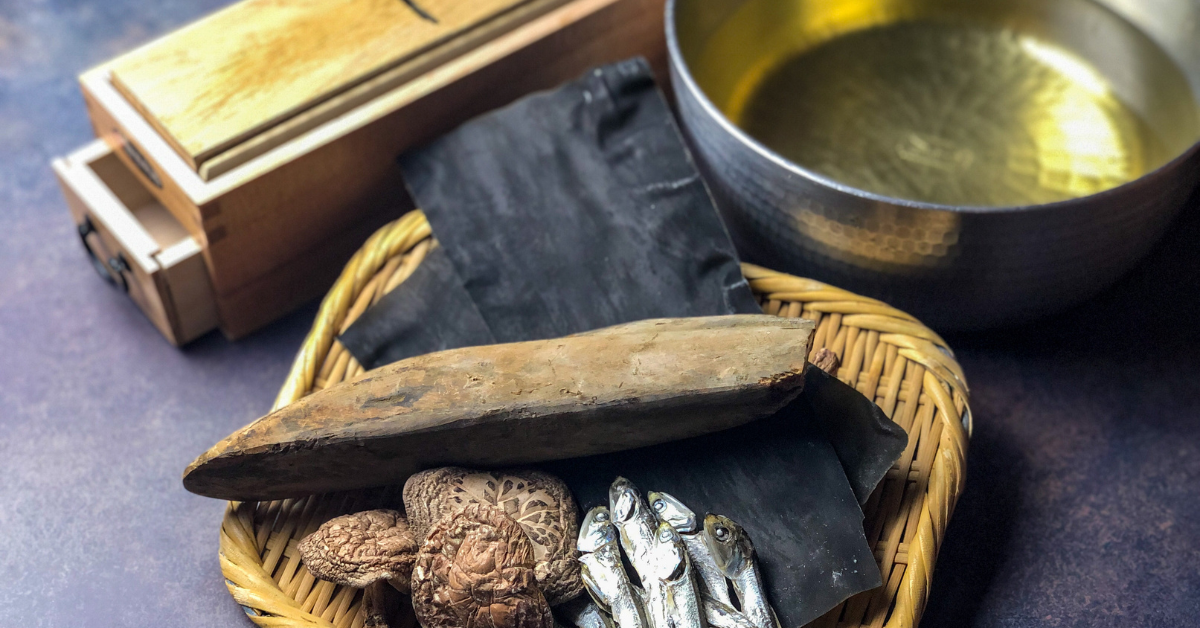Dashi is the essential foundation of Japanese cuisine, a method of extracting the maximum umami from ingredients. In recent years, it has attracted global attention from chefs and food scholars, becoming indispensable for understanding Japanese cuisine.
What is Dashi?
Dashi refers to a liquid extracted from ingredients containing umami compounds. It is comparable to bouillon or consommé in Western cuisine, but the Japanese method is distinctive because it creates a clearer, more refined flavor in a shorter time.
The main ingredients used are kelp, dried bonito flakes, dried sardines, and dried shiitake mushrooms. Each ingredient contributes a different character to the flavor. The most common form is “awase dashi” (combined stock), which blends kelp and bonito flakes to create balance and depth.
| Type of Dashi | Main Ingredient | Characteristics |
|---|---|---|
| Kelp Dashi | Kelp | Elegant and mild, often used in Buddhist vegetarian cuisine |
| Bonito Dashi | Bonito flakes | Rich aroma and strong flavor, ideal for miso soup |
| Sardine Dashi | Dried sardines | Intense and regional, common in local dishes |
| Shiitake Dashi | Dried shiitake | Aromatic and deep, essential for vegetarian cooking |
| Awase Dashi | Kelp + Bonito | Umami synergy, the foundation of Japanese cuisine |
Umami Compounds in Dashi
The special quality of dashi comes from scientifically identified umami compounds.
| Ingredient | Main Umami Compound | Flavor Profile |
|---|---|---|
| Kelp | Glutamic acid | Gentle and mild |
| Bonito | Inosinic acid | Strong, adds body to the aftertaste |
| Shiitake | Guanylic acid | Highly aromatic, provides depth |
Combining multiple umami compounds greatly enhances flavor intensity. This is why “awase dashi,” made from kelp and bonito, is the most widely used in Japanese cooking.
The Role of Dashi in Japanese Cuisine
Japanese cuisine emphasizes highlighting the natural flavor of ingredients, using seasonings sparingly. For this reason, dashi serves as the “foundation of flavor.”
Here are some representative dishes:
| Dish | Type of Dashi | Characteristics |
|---|---|---|
| Miso soup | Bonito or Awase | Umami highlights the ingredients |
| Clear soup | Kelp + Bonito | Refined taste, a symbol of kaiseki cuisine |
| Nimono (simmered dishes) | Kelp, Bonito, Sardine | Base flavor that penetrates vegetables and meat |
| Soba/Udon broth | Sardine + Bonito | Strong and flavorful |
| Chawanmushi (egg custard) | Kelp + Bonito | Smooth texture with gentle umami |
This shows that most Japanese dishes are built upon dashi.
Cultural Significance of Dashi
Dashi is not merely a cooking method but also carries cultural and spiritual meaning in Japan.
- In Buddhist vegetarian cuisine, kelp and shiitake dashi replace animal-based stocks, aligning with religious dietary rules.
- In home cooking, dashi is the flavor of “mother’s cooking,” passed down through generations.
- In high-end cuisine, the quality of clear soup dashi reflects the chef’s skill.
Dashi is present in daily meals as well as in ceremonial and celebratory dishes, making it a symbol of both everyday and sacred Japanese food culture.
Methods of Making Dashi
Temperature and timing are key. Kelp should be removed just before boiling, while bonito flakes should be steeped briefly in hot water and strained immediately to prevent bitterness.
For everyday cooking, the cold-water extraction method (mizudashi) is popular: soaking kelp in cold water overnight yields a clear and subtle stock.
| Method | Characteristics | Best For |
|---|---|---|
| Boiling | Quick, produces concentrated stock | Miso soup, simmered dishes |
| Cold-water | Clean and refined flavor | Clear soups, egg custards |
| First stock | Most refined, from the first extraction | Clear soups, rolled omelets |
| Second stock | Reused after first extraction | Stews, hot pots |
Health Benefits of Dashi
Dashi offers not only taste but also significant health advantages.
- Enhances satisfaction with less salt
- Kelp provides minerals, bonito contains essential amino acids
- Low in calories and easy to digest
This makes dashi useful for diets, reducing salt intake, and maintaining overall health.
Global Spread of Dashi
“UMAMI” has become a global culinary term, and the concept of dashi has crossed borders. Many international restaurants now incorporate kelp or bonito into sauces and soups, expanding the possibilities of French and Italian cuisine.
In vegan and vegetarian cooking, shiitake and kelp dashi are highly valued as a way to create depth without using meat.
Conclusion
Dashi is the foundation of Japanese cuisine, a method of drawing out the natural umami of ingredients. By combining kelp, bonito, shiitake, and other ingredients, Japanese chefs achieve flavors that are both simple and profound.
Its cultural roots, health benefits, and growing global recognition show that dashi is not just a cooking technique but a symbol of Japanese culinary identity.






